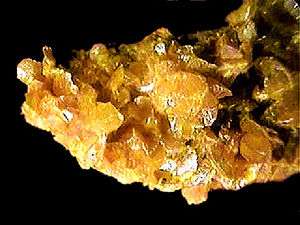Orpiment
| Orpiment | |
|---|---|
|
Orpiment | |
| General | |
| Category | Sulfide mineral |
| Formula (repeating unit) | As2S3 |
| Strunz classification | 2.FA.30 |
| Crystal system | Monoclinic |
| Crystal class |
Prismatic (2/m) H-M symbol: (2/m) |
| Space group | P21/n |
| Unit cell |
a = 11.475(5), b = 9.577(4) c = 4.256(2) [Å], β = 90.45(5)°; Z = 4 |
| Identification | |
| Color | Lemon-yellow to golden or brownish yellow |
| Crystal habit | Commonly in foliated columnar or fibrous aggregates; may be reniform or botryoidal; also granular or powdery; rarely as prismatic crystals |
| Twinning | On {100} |
| Cleavage | Perfect on {010}, imperfect on {100}; |
| Tenacity | Sectile |
| Mohs scale hardness | 1.5 - 2 |
| Luster | Resinous, pearly on cleavage surface |
| Streak | Pale lemon-yellow |
| Diaphaneity | Transparent |
| Specific gravity | 3.49 |
| Optical properties | Biaxial (−) |
| Refractive index | nα = 2.400 nβ = 2.810 nγ = 3.020 |
| Birefringence | δ = 0.620 |
| Pleochroism | In reflected light, strong, white to pale gray with reddish tint; in transmitted light, Y = yellow, Z = greenish yellow |
| 2V angle | Measured: 30° to 76°, Calculated: 62° |
| Dispersion | r > v, strong |
| References | [1][2][3] |
Orpiment is a deep orange-yellow colored arsenic sulfide mineral with formula As
2S
3. It is found in volcanic fumaroles, low temperature hydrothermal veins, and hot springs and is formed both by sublimation and as a byproduct of the decay of another arsenic mineral, realgar. It takes its name from the Latin auripigmentum (aurum − gold + pigmentum − pigment) because of its deep-yellow color.
Historical uses
Orpiment was traded in the Roman Empire and was used as a medicine in China even though it is very toxic. It has been used as a fly poison and to tip arrows with poison. Because of its striking color, it was of interest to alchemists, both in China and the West, searching for a way to make gold.
For centuries, orpiment was ground down and used as a pigment in painting and for sealing wax, and is even used in Ancient China as a correction fluid.[4] It was one of the few clear, bright-yellow pigments available to artists until the 19th century. However, its extreme toxicity and incompatibility with other common pigments, including lead and copper-based substances such as verdigris and azurite,[5] meant that its use as a pigment ended when cadmium yellows, chromium yellows and organic dye-based colors were introduced during the 19th century.
Orpiment, as the Latin Auripigmentum, is mentioned by Robert Hooke in Micrographia for the manufacture of small shot in the 17th century.[6]
Contemporary uses
Orpiment is used in the production of infrared-transmitting glass, oil cloth, linoleum, semiconductors, photoconductors, pigments, and fireworks. Mixed with two parts of slaked lime, orpiment is still commonly used in rural India as a depilatory. It is used in the tanning industry to remove hair from hides.
Physical and optical properties
Orpiment is a common monoclinic arsenic sulfide mineral. It has a Mohs hardness of 1.5 to 2 and a specific gravity of 3.49. It melts at 300 °C to 325 °C. Optically it is biaxial (−) with refractive indices of a = 2.4, b = 2.81, g = 3.02.
Crystal structure
-

Orpiment's unit cell -

Orpiment's crystal structure consists of sheets -

The sheets are stacked into layers
Gallery of orpiment specimens
-

Orpiment and realgar on a vuggy, quartz matrix, Nishinomaki Mine, Gunma Prefecture, Japan. Size: 5.5 x 4.0 x 3.8 cm.
-

El'brusskiy arsenic mine, Kabardino-Balkarian Republic, Northern Caucasus Region, Russia. Size 5.8 x 3.5 x 1.7 cm.
See also
References
- ↑ http://rruff.geo.arizona.edu/doclib/hom/orpiment.pdf Handbook of Mineralogy
- ↑ http://www.mindat.org/min-3021.html Mindat.org
- ↑ http://webmineral.com/data/Orpiment.shtml Webmineral data
- ↑ http://news.xinhuanet.com/newscenter/2006-07/29/content_4890298.htm
- ↑ Fitzhugh, E.W., Orpiment and Realgar, in Artists’ Pigments, A Handbook of Their History and Characteristics, Vol 3: E.W. Fitzhugh (Ed.) Oxford University Press 1997, p. 52
- ↑ Hooke, Robert. "Micrographia". Project Gutenberg. Retrieved 24 October 2012.
- The Merck Index: An Encyclopedia of Chemicals, Drugs, and Biologicals. 11th Edition. Ed. Susan Budavari. Merck & Co., Inc., N.J., U.S.A. 1989.
- William Mesny. Mesny’s Chinese Miscellany. A Text Book of Notes on China and the Chinese. Shanghai. Vol. III, (1899), p. 251; Vol. IV, (1905), pp. 26.
- Fitzhugh, E.W., Orpiment and Realgar, in Artists’ Pigments, A Handbook of Their History and Characteristics, Vol 3: E.W. Fitzhugh (Ed.) Oxford University Press 1997, p. 47 – 80
External links
- Webexhibits "Pigments Through the Ages: Orpiment"
- Babylonian Talmud Tractate Chullin see Rashi 'haZarnich' (Hebrew)
- Orpiment, Colourlex
| Wikimedia Commons has media related to Orpiment. |
